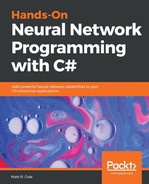Well, folks, I think it's time to wrap this chapter up and move on. You should commend yourself, as you've written a complete autoencoder from start to (almost) finish. In the accompanying source code, I have added even more functions to make this more complete, and for you to have a better starting point from which to make this a powerful framework for you to use. As you are enhancing this, think about the things you need your autoencoder to do, block in those functions, and then complete them as we have done. Rather than learn to use an open-source framework, you've built your own—congratulations!
I have taken the liberty of developing a bit more of our autoencoder framework with the supplied source code. You can feel free to use it, discard it, or modify it to suit your needs. It's useful, but, as I mentioned, please feel free to embellish this and make it your own, even if it's just for educational purposes.
So, let's briefly recap what we have learned in this chapter: we learned about autoencoders and different variants, and we wrote our own autoencoder and created some powerful functionality. In the next chapter, we are going to move on to perhaps my most intense passion, and I hope it will soon be yours, swarm intelligence. There's going to be some theory, of course, but, once we're discussed that, I think you're going to be impressed with what particle swarm optimization algorithms can do!
